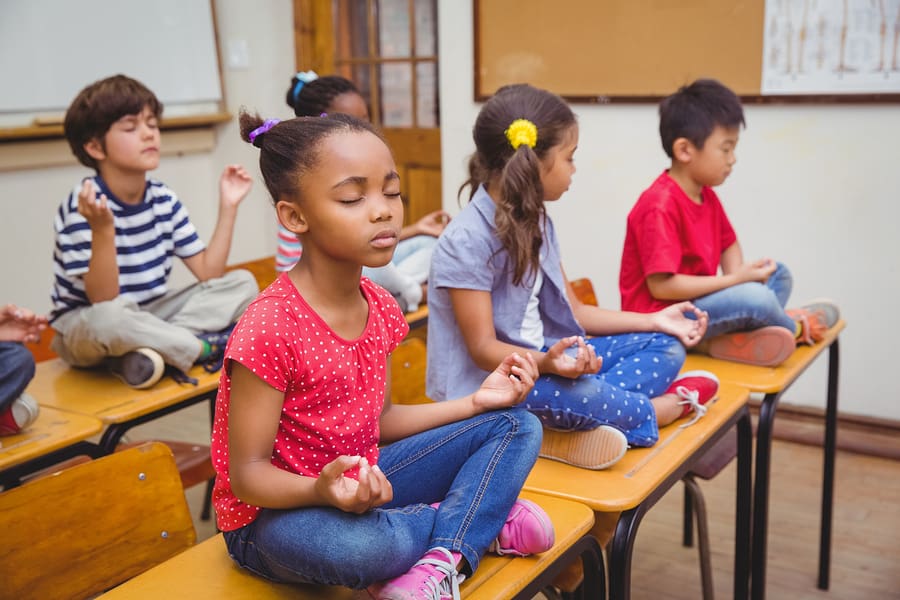Blog Post #6: Social Emotional/Mindfulness
 Hartmann Garner, A. (2017, August 26). Creating a mindful classroom environment. Getting Smart. Retrieved March 26, 2023, from https://www.gettingsmart.com/2017/08/26/creating-a-mindful-classroom-environment/
Hartmann Garner, A. (2017, August 26). Creating a mindful classroom environment. Getting Smart. Retrieved March 26, 2023, from https://www.gettingsmart.com/2017/08/26/creating-a-mindful-classroom-environment/ This week, I chose to embrace the topic by using the app Calm every morning when I woke up and every night before I went to sleep. I could not have loved it more! They had amazing selections for meditations for sleep so I was able to use a different choice every night. My favorite was "Quieting the Mind and Body" because it helped reduce the hyperactivity that my thoughts go through every night before bed. In the mornings I would use "Daily Calm" or "Morning Stretch" to prepare myself for the days ahead.
I thoroughly enjoyed my experience using Calm and I am able to see the impact it made on me in just a week! I noticed I had much more energy in the mornings and was able to get my work done in a more timely manner. With my free time, I was able to enjoy more of my hobbies and activities that I don't normally get to work on during a regular school week. Having longer, healthier sleep each night was definitely the best consequence of this app, and I feel that many people -- children and adults alike --would benefit from improved sleeping patterns... especially teachers!
Teacher burnout exists. And it's time we find better ways to battle it.
Take a look at the male teacher in the beginning of "Room to Breathe" (2012). He literally claims to have given up and that he has too many students to discipline at the same time, leading to the chaotic classroom environment. His experience is not out of the ordinary for many teachers across the country. One distracting student is able to disrupt the entire learning flow in too many classrooms. Statistically speaking, "61% of teachers report being stressed out... 58% of teachers say their mental health is not good... [and] public school educators are quitting their jobs at the highest rate on record" ("Why is Mindfulness...", n.d.). Applying my own experience to these numbers, it is possible that better sleep and increased meditative practices could benefit these educators, therefore saving more students in the process.
Teachers are not the only people in school that suffer from stress, burnout, or other mental struggles. Students everyday are straying further and further away from healthy habits and mindsets. While most students can relate to some sort of lack of social emotional awareness, "students of color, students with disabilities and learning differences, English language learners, lesbian, gay, bisexual, transgender and questioning or queer (LGBTQ) youth, and others" are finding disproportionately lower achievement rates compared to the general youth in schools ("Social Emotional Learning", 2022). This disparity needs to be corrected immediately or we will continue seeing heartbreaking effects in our schools.
The question is how?
Implementing strategies such as "deep breathing exercises or a body scan" can increase mindfulness in our students (Schwartz, 2019). Teachers can introduce these practices in the beginning, middle, or end of class depending on what their students need that day. These can take place weekly, daily, or at a spontaneous rate whenever is needed. There are no rules or regulations for mindfulness; we just have to try our best to improve the SEL in the classroom.
References
Long, R. (director/ producer). (2012) Room To Breathe [film]. ZAP Zoetrope Aubry Productions.
Schwartz, K. (2019). Nine ways to ensure your mindfulness teaching is trauma informed. KQED Mindshift. Link
Social Emotional Learning (2022, November 14). New York State Department of Education. https://www.p12.nysed.gov/sss/sel
Why is Mindfulness Needed in Education. (n.d.). Mindful Schools. Link
Hi Colleen,
ReplyDeleteI'm glad to hear you had such a great experience using the app Calm! Like you said, I agree that having healthier and longer sleep is a good consequence of having a meditation app. I used the app called Smiling Mind. I really enjoyed this app because there was so many meditation options. When you make an account you can select that you are an educator and there are meditations for teachers. I thought this was a great feature to help prevent teacher burnout. You also could choose how long you wanted to meditate for which I liked incase you don't have a lot of time. Personally, I noticed I had a more positive attitude using this app. I think implementing meditation in the classroom is a great idea. I like how you mentioned the use of deep breathing exercises or a body scan. I think it is important that students take a few minutes in their day to meditate and clear their mind so they aren't so stressed with school and the work load.
Hi Colleen,
ReplyDeleteThe app Calm would definitely be effective in a classroom. It has songs that helps in relaxing and taking a breather from a stressful day. This would help in ensuring the students are taking a minute to breathe and gather their thoughts. As future educators, using different techniques in the classroom to make it a positive and safe environment for students is extremely crucial. It is important for students to know that stress is something that even teachers go through in life. When thinking about social emotional/mindfulness, this is something that most students struggle with. Not only is school a lot to handle, but so is life as a whole. Being a role model for students and ensuring that they know that you are there for them, would benefit them in many ways mentally. I believe that it is important to incorporate mindfulness into teaching routines. If students see that teachers find it important to meditate, then they will want to try it as well. Overall, mindfulness can really help students relieve stress in a more effective and positive way in which it can benefit them in school and life.